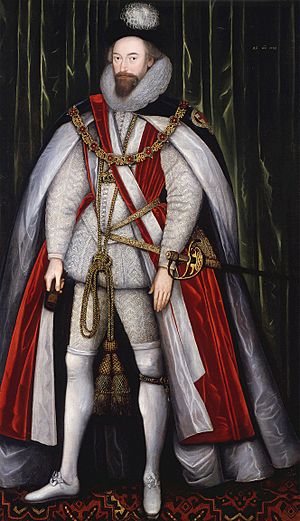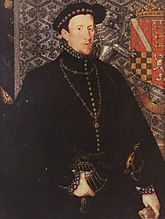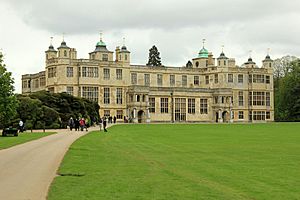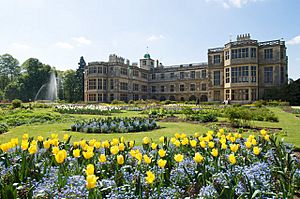Thomas Howard, 1st Earl of Suffolk facts for kids
Quick facts for kids
Admiral The Right Honourable
The Earl of Suffolk
|
|
|---|---|
 |
|
| Lord High Treasurer | |
| In office 11 July 1614 – July 1618 |
|
| Preceded by | The Lord Ellesmere |
| Succeeded by | George Abbot, Archbishop of Canterbury |
| Lord Chamberlain of the Household | |
| In office c. 1603 – c. 1614 |
|
| Preceded by | The Lord Hunsdon |
| Succeeded by | The Earl of Somerset |
| Personal details | |
| Born | 24 August 1561 |
| Died | 28 May 1626 (aged 64) |
| Resting place | St Mary the Virgin, Saffron Walden, Essex, England |
| Spouses | Mary Dacre Katherine Knyvet |
| Children | Theophilus Howard, 2nd Earl of Suffolk Elizabeth Howard Robert Howard Sir William Howard Catherine Howard Thomas Howard, 1st Earl of Berkshire Frances Howard Sir Charles Howard Henry Howard Edward Howard, 1st Baron Howard of Escrick Margaret Howard family-name - Howard |
| Parents |
|
Thomas Howard, the 1st Earl of Suffolk, was an important English nobleman and admiral. He was born on August 24, 1561, and passed away on May 28, 1626. He was a key member of the House of Howard, a very powerful family in England.
Thomas was the second son of Thomas Howard, 4th Duke of Norfolk, and his mother was Margaret Audley, Duchess of Norfolk. His family owned Audley End House in Essex, which was a very grand home. He also lived in Suffolk House near Westminster in London.
Contents
Early Life and Family
Thomas Howard was born at Audley End on August 24, 1561. He was one of four children his father, the 4th Duke of Norfolk, had with his second wife, Margaret Audley. His older sister, Elizabeth, sadly died when she was very young. He also had younger siblings named Margaret and William.
When his mother, Margaret Audley, passed away in January 1564, Thomas inherited some of the family's properties. These included the lands around Saffron Walden.
Thomas's father faced serious trouble with Queen Elizabeth I. He was involved in plots against the Queen and was arrested in 1569. After being briefly released, he was imprisoned again in 1571. He faced severe consequences in June 1572, when Thomas was almost eleven years old.
After his father's death, Thomas and his siblings were looked after by their uncle, Henry Howard, Earl of Northampton. Their uncle also made sure they received a good education. They lived with him at Audley End during this time. Because of his father's actions, much of their family's property was taken by the Crown. However, Thomas and his siblings were able to get some of it back later.
While his father was imprisoned, he wanted Thomas to marry his stepsister, Mary Dacre. Thomas did marry Mary, but she passed away without having children in April 1578.
Later, around 1582, Thomas married again. His second wife was Katherine Knyvet. She was known for her beauty and was the daughter of Sir Henry Knyvet. Katherine outlived Thomas, passing away in 1633.
Thomas Howard's Children
Thomas and Katherine had many children together:
- Theophilus Howard, 2nd Earl of Suffolk (born 1582, died 1640)
- Elizabeth Howard (born around 1583, died 1658)
- Sir Robert Howard (born 1598, died 1653)
- Sir William Howard (born 1586, died before 1672)
- Thomas Howard, 1st Earl of Berkshire (born 1587, died 1669)
- Catherine Howard (born around 1588, died 1673)
- Frances Howard (born 1590, died 1632)
- Sir Charles Howard (born 1591, died 1626)
- Henry Howard (born 1592, died 1616)
- Edward Howard, 1st Baron Howard of Escrick (died 1675)
- Margaret Howard (born around 1599, died 1608)
In December 1584, Thomas Howard was given back his noble status and became known as Lord Thomas Howard. He was a skilled naval commander.
Fighting the Spanish Armada
Lord Thomas commanded a ship called the Golden Lion during the attack on the Spanish Armada in 1588. This was a huge fleet of ships sent by Spain to invade England. On July 25, 1588, the Golden Lion was one of three ships that fought back against the Spanish galleasses. These were large, oar-powered warships protecting the Spanish fleet.
The very next day, he was knighted aboard the Ark Royal. This honor was given to him by his relative, Admiral Charles Howard, 1st Earl of Nottingham.
Expedition to the Azores
In 1591, Lord Thomas was sent with a group of ships to the Azores islands. His mission was to intercept Spanish treasure fleets returning from America. However, one fleet reached Spain before he arrived. The second fleet was not expected until September.
Because of the long wait, he had to land his sick sailors and repair his ships. He barely managed to get back to sea near Flores when his scouts reported an approaching fleet. To his surprise, it was not the treasure fleet. Instead, it was a powerful Spanish force sent to destroy his squadron.
Most of Howard's fleet managed to escape just in time. However, one ship, the Revenge, was left behind. It was commanded by Sir Richard Grenville. The Revenge tried to fight its way through the Spanish ships. After a long battle, the Revenge was almost completely destroyed, and Sir Richard Grenville was badly wounded. The ship was eventually forced to surrender.
Capture of Cadiz
In 1596, Howard served as the vice-admiral in an important expedition against Cadiz in Spain. His fleet successfully defeated a Spanish fleet and captured the town.
Queen Elizabeth I thought highly of him. In April 1597, he was made a Knight of the Garter, which is a very special honor. In June of the same year, he sailed on another expedition to the Azores. This trip was not successful, even though he had helped pay for it.
Political Career and Influence
In late 1597, Thomas Howard became very ill. While he was recovering, he was given the title of Baron Howard de Walden. This allowed him to attend Parliament, which he did starting in January 1598. In 1599, he took command of the fleet in The Downs. He also became an admiral that same year.
On February 13, 1601, he was made Constable of the Tower of London. This happened after a rebellion led by the Earl of Essex. Thomas Howard was part of the group that put Essex and Southampton on trial. He was also made High Steward of Cambridge University and held this position until 1614. He even received a Master of Arts degree from Cambridge in 1605.
Rise to Power Under King James I
Thomas Howard was a friend of Sir Robert Cecil. He became the acting Lord Chamberlain at the end of 1602. He even hosted Queen Elizabeth at the London Charterhouse in January 1603, shortly before she passed away.
When James I became king, Howard quickly gained his favor. On April 6, 1603, he was appointed Lord Chamberlain. The next day, he became a Privy Counsellor. Later that year, on July 21, 1603, he was given the title of Earl of Suffolk. He also became a commissioner for creating Knights of the Bath. From 1604 to 1618, he was a commissioner for the Earl Marshalcy. He was made Lord Lieutenant of Suffolk in 1605, and had been Lord Lieutenant of Cambridgeshire a few years earlier.
Suffolk accepted a gift from the Spanish ambassador during peace treaty talks in 1604. His wife, the Countess of Suffolk, was even more involved. She accepted a large yearly payment from the Spanish. While Suffolk was not as pro-Spanish as his wife, she was seen as having a lot of influence over him in political matters. This would later cause him problems.
By 1605, Suffolk, along with Cecil (now Earl of Salisbury), the Earl of Northampton, and the Earl of Worcester, were King James's main advisors. Suffolk and Salisbury were both aware of a warning about the Gunpowder Plot. This was a plan to blow up the Houses of Parliament. Suffolk even examined the cellar where the gunpowder was hidden. Later that night, the plot was discovered. Suffolk was part of the group that investigated and tried the plotters.
King James considered Suffolk to be loyal and trustworthy. By 1607, a new house called Charlton Park was finished. This house is still home to his descendants today. In December 1608, Suffolk's daughter, Catherine, married William Cecil, the son of the Earl of Salisbury. When Salisbury passed away in 1612, Suffolk was appointed one of the Lords of the Treasury.
Even though he did not like Sir Robert Carr, a favorite of the King, Suffolk supported his daughter Frances's wish to divorce her husband and marry Carr. She did so in December 1613.
On July 8, 1614, Suffolk became the Chancellor of the University of Cambridge. A few days later, on July 11, 1614, he was made Lord High Treasurer. This was a very important financial role. His new son-in-law, Somerset, took his place as Lord Chamberlain. At this point, Suffolk and his family had a lot of power at court.
Challenges and Downfall
In 1615, Suffolk's good fortune began to change. King James became very fond of Sir George Villiers. Also, Suffolk's daughter Frances, now Countess of Somerset, was involved in a scandal. Suffolk was accused of trying to hide information about the crime, but he managed to get through it.
However, Suffolk then made a mistake. He tried to reduce Villiers's growing power by promoting another young man to gain the King's favor. This plan failed completely. Instead, it led Villiers, who was now the Marquess of Buckingham, to attack Suffolk's actions as Lord High Treasurer.
Suffolk's personal finances were always difficult. His early naval adventures almost made him bankrupt. Even with help from Queen Elizabeth, he struggled. Under King James, his position at court helped him financially. He invested in land and received money from relatives. He had to sell his London home, the Charterhouse, in 1611. However, he inherited another house in 1614.
Suffolk also spent a lot of money on grand building projects. Audley End House, built between 1603 and 1616, was the largest private house in England. He also added an expensive new part to his London house. His wife built Charlton Park on her inherited lands. Suffolk also spent a lot to support his children at court and provide them with good marriage portions. While this helped his children, it created huge debts for him. By 1618, he owed a lot of money. His role as Lord High Treasurer in 1614 gave him a chance to improve his finances by selling favors and making deals. However, this role also led to his downfall.
Arrest and Later Life
Buckingham informed King James about Suffolk's improper actions in the Treasury. There were claims that Lady Suffolk pressured people who were owed money by the Crown and demanded bribes from them. As a result, Suffolk was suspended from his role as Treasurer in July 1618.
In early 1619, his wife became ill, which affected her famous beauty. Suffolk himself claimed to be ill to avoid a trial. These efforts did not work. In October 1619, he, his wife, and their associate Sir John Bingley were accused of corruption. On November 13, 1619, they were found guilty. They were ordered to pay a large fine and were sentenced to prison.
After ten days, Suffolk and his wife were released. They asked Buckingham to help them. Even though Suffolk tried legal ways to avoid losing his property, Buckingham was willing to be kind now that Suffolk's power was gone. Buckingham arranged for Suffolk to meet the King. The fine was later reduced to £7,000. In 1623, Suffolk's youngest son, Edward, married Buckingham's niece.
While Suffolk never held a high government position again, he remained active in the House of Lords. He passed away at Charing Cross on May 28, 1626, and was buried on June 4 at Saffron Walden.
|









